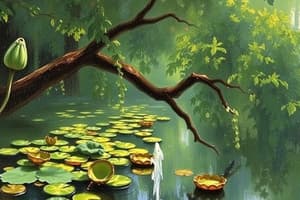Podcast
Questions and Answers
What is osmosis?
What is osmosis?
What does a selectively permeable membrane do?
What does a selectively permeable membrane do?
Allows certain substances to cross more easily than others.
What is a solute?
What is a solute?
Minor component in a solution that dissolves.
What is a solvent?
What is a solvent?
Signup and view all the answers
What defines a solution?
What defines a solution?
Signup and view all the answers
What does hydrophilic mean?
What does hydrophilic mean?
Signup and view all the answers
What does hydrophobic mean?
What does hydrophobic mean?
Signup and view all the answers
How does water move in osmosis?
How does water move in osmosis?
Signup and view all the answers
What are polar molecules?
What are polar molecules?
Signup and view all the answers
What is net movement in the context of osmosis?
What is net movement in the context of osmosis?
Signup and view all the answers
Study Notes
Osmosis and Membranes
- Osmosis refers to the diffusion of water across a selectively permeable membrane, equalizing solute concentrations on both sides.
- A selectively permeable membrane permits certain substances to pass through more easily, impacting the movement of water and solutes.
Solutions and Components
- Solute is the minor component in a solution that dissolves in a solvent; it plays a crucial role in determining solution concentration.
- Solvent is the substance in which solutes dissolve; water is known as the universal solvent due to its ability to dissolve many substances.
- A solution is the resulting mixture of solute and solvent, where both components are evenly distributed.
Molecular Properties
- Hydrophilic substances are those that are attracted to water; they tend to dissolve easily in aqueous environments.
- Hydrophobic substances repel water, often leading to separation from aqueous solutions.
Water Dynamics
- Water movement typically flows from areas of low solute concentration (high free water molecules) to areas of high solute concentration (low free water molecules).
- Polar molecules interact with water by clustering around hydrophilic solute molecules, enhancing solubility in water.
- Net movement of water occurs down its concentration gradient, emphasizing the natural tendency for water to move towards areas of higher solute concentration until equilibrium is reached.
Studying That Suits You
Use AI to generate personalized quizzes and flashcards to suit your learning preferences.
Description
Explore the concepts of osmosis, selectively permeable membranes, and the roles of solute and solvent in solutions. This quiz covers the molecular properties related to water dynamics, including hydrophilic and hydrophobic substances. Test your knowledge on how water interacts with different components in biological systems.




